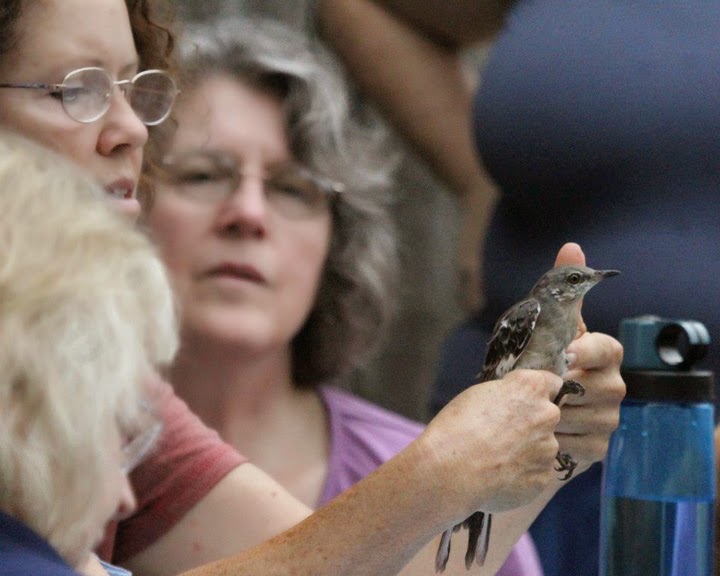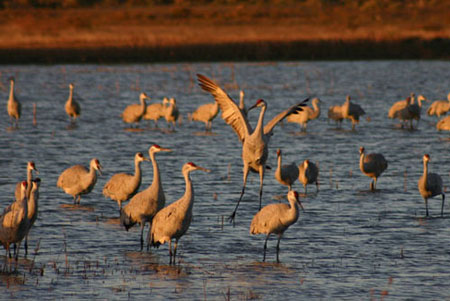Katherine Noblet of Johnson City, Tennessee, is one of those lucky individuals with repeated wintering hummingbird visitors. This year, she has a Rufous female wintering in her yard and frequenting the two nectar feeders she makes available.
Photo credit: Katherine Noblet
Mark Armstrong, Master Bander of hummingbirds and songbirds from Knoxville, Tennessee visited her home on November 26th to trap and band the hummingbird for a positive identification of the species and to record the birds health, age and other identifying characteristics.
Above and below, you see Mark setting the trap on a portable table in the area where the feeder normally hangs. The pink ribbon you see at the bottom left of the trap marks the bottom of the trap door that he raises and lowers with fishing wire. He will next place the feeder inside the trap (shown below), raise the door by holding it up with the fishing wire, and position himself away from the feeder, releasing the door when the hummer goes inside to feed. Photo credit: Katherine Noblet
Once the hummingbird goes inside, the door is lowered, the hummer is removed and briefly placed in a mesh bag until Mark is in position to band it. Below, Kathy Noblet takes a close look at the hummer she has been watching and photographing since November 11th. Janie Kading, Mark's wife and recording assistant holds the hummer.
Mark is skillful and efficient with his work, placing the band on the hummingbird's leg, while Jane records the band number and the measurements obtained. The examination process lasts about ten minutes.Below, Mark takes a wing measurement. Wing measurements can distinguish species, as well as, distinguish males from females. The female Allen's species looks very similar to the female Rufous and the two are hard to distinguish in the field. They both have green feathers on their backs and rufous in their tail feathers. Wing measurements and width and shape of tail feathers are two distinguishing characteristics that separate the two species.
A tail measurement is taken below. The Rufous species breeds in northwestern North America, in Idaho, Oregon and north to Alaska, and primarily winters in northern and central Mexico.
Wintering hummingbirds reported in the southeastern United States in the states of Alabama, Georgia, Florida and Tennessee have been documented since 1988 by Bob and Martha Sargent of the Hummer Study Group. Their records show a rapid increase in the number of wintering hummingbirds, as well as, a "clumping" distribution in the southeastern states.
Above, Mark examines the beak to help determine the age of the bird. Grooving in the beak indicates a juvenile bird, while no grooving indicates a mature bird. Kathy's Rufous female is a mature bird. Below, you see the Rufous coloration and shape of the tail feathers, helping to confirm that this individual is a Rufous female.
Kathy's location in Johnson City, Tennessee, is one of the areas that is attracting wintering hummingbirds that migrate from western breeding areas. In 2008 she had a male Rufous and the first Calliope recorded in the area. Again in 2011, she had an immature male Rufous that frequented her feeders from October 21-December 13. This year she had a Rufous visit briefly November 1st, and the female pictured here, arrived November 11th and continues to visit her feeders.
Not all of the hummingbirds that are sighted in Tennessee will remain here. Many Rufous Hummingbirds are also being reported in North Carolina.
Above, you can see the gorget feathers that appear on this female's throat. Each individual female has its own arrangement and number of gorget feathers.
Above and below, Mark places the hummer in Kathy's hand for release. True to the nature of many Rufous individuals, she remains still until she recognizes she is free.
Photo credit: Katherine Noblet
The female visited a feeder soon after her banding session and the photo below shows her visiting the porch feeder later in the day. Kathy has a creative blind that she has made from foam core board, the backing often used for framing art. She cut the board to a size that slides into the frame of her storm door windows, and added an opening equipped with a curtain through which she can insert her camera lens. This allows her to photograph the hummer from inside the house without disturbing it and without the obstruction of window panes. Her blinds have allowed her to obtain beautiful images of the hummingbird as it visits her nectar feeders.
Photo credit: Katherine Noblet
Links and Resources:
Previous reports on Katherine Noblet's wintering hummingbirds
Western Hummingbirds Wintering in Tennessee
In recent years, fourteen species of hummingbirds have been documented in the east during fall and winter months. In east Tennessee, report sightings to Mark Armstrong at Woodthrush@bellsouth.net or 865-748-2224. For a list of contact information for other eastern areas, visit winter reporting on the Hummingbird Study Group website or report sightings to Bob and Martha Sargent, Rubythroat@aol.com or 205-681-2888.
Other blog posts on Wintering hummingbirds in Tennessee
Visit Bob Sargent's information on wintering hummingbirds
Bob Sargent describes the Rufous Hummingbird as very cold-hardy.
Sargent on wintering Calliopes and the Allen's Hummingbird
Hummingbird banding
Hummingbirds in watercolor
Hummingbird art on Vickie's Sketchbook blog


























































